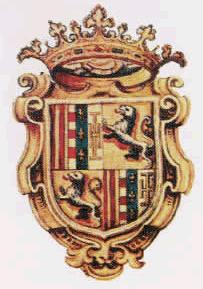The Acquaviva family
 The Acquaviva family, who assumed the name of Aragon at the end of the fifteenth century, was considered one of the seven great families of the Kingdom of Naples. Dukes of Atri and Counts of Conversano but also, in the collateral branches, the Princes of Caserta and Dukes of Nardò, they were present in the various territories of the Kingdom – in Apulia, Abruzzo, Campania and increasingly, since the sixteenth century, in the capital, Naples. Nobles active in war, between the end of the fifteenth century and the first half of the sixteenth they adopted a new social model which accorded importance to cultural education, patronage and the “moral virtues”, as distinguishing features of the nobility, producing prominent representatives in the religious world, first among them Claudio AcquavivaClaudio Acquaviva d’Aragona (1543-1615) was born in Atri, the ninth of ten children of Duke Giannantonio Donato. After studying law, he began his career as a priest and entered as a novice in the Society of Jesus in 1567. Upon the death of Everardo Mercuriano, he was elected the fifth Superior General of the Order in 1581. He was the youngest General in the history of the Society and the one that remained in office for the longest time: 34 years., who was elected the fifth General of the Society of Jesus in 1581. The link between power and culture thus became ever closer, so that the places where they lived in Abruzzo, Apulia and finally, in Naples, were centres of culture, veritable and real Renaissance and, later, Baroque courts. Commissioning works of art of great quality not only meant establishing themselves as patrons but, above all, conceiving of a political project of affirmation and legitimacy: cultural and artistic patronage were, in fact, the basis for affirming the prestige of the family and placing it among the highest nobility of the kingdom (in the photo: the coat of arms of the Acquaviva).
The Acquaviva family, who assumed the name of Aragon at the end of the fifteenth century, was considered one of the seven great families of the Kingdom of Naples. Dukes of Atri and Counts of Conversano but also, in the collateral branches, the Princes of Caserta and Dukes of Nardò, they were present in the various territories of the Kingdom – in Apulia, Abruzzo, Campania and increasingly, since the sixteenth century, in the capital, Naples. Nobles active in war, between the end of the fifteenth century and the first half of the sixteenth they adopted a new social model which accorded importance to cultural education, patronage and the “moral virtues”, as distinguishing features of the nobility, producing prominent representatives in the religious world, first among them Claudio AcquavivaClaudio Acquaviva d’Aragona (1543-1615) was born in Atri, the ninth of ten children of Duke Giannantonio Donato. After studying law, he began his career as a priest and entered as a novice in the Society of Jesus in 1567. Upon the death of Everardo Mercuriano, he was elected the fifth Superior General of the Order in 1581. He was the youngest General in the history of the Society and the one that remained in office for the longest time: 34 years., who was elected the fifth General of the Society of Jesus in 1581. The link between power and culture thus became ever closer, so that the places where they lived in Abruzzo, Apulia and finally, in Naples, were centres of culture, veritable and real Renaissance and, later, Baroque courts. Commissioning works of art of great quality not only meant establishing themselves as patrons but, above all, conceiving of a political project of affirmation and legitimacy: cultural and artistic patronage were, in fact, the basis for affirming the prestige of the family and placing it among the highest nobility of the kingdom (in the photo: the coat of arms of the Acquaviva).
